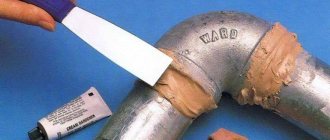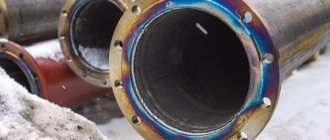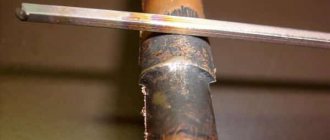Is it even possible to do this?
It is quite possible to patch up a pressure pipe that unexpectedly leaks on your own using improvised means.
The only caveat is if the leak is insignificant , and the water oozes slightly, and does not gush in an endless stream.
When the accident is more serious, you will need to urgently tighten the valve that controls the water supply to the coolant, and then call a repair service.
Rules for choosing a material to solve a problem
When the cause of the pipe damage has been established, it is necessary to look for acceptable repair methods. There are several of them. Only most are suitable for low water pressure in the water supply circuit or heating system.
The most common way out of a difficult situation is to use an industrial clamp (screed). This is a metal ring with thick walls, a rubberized inner surface and a fastening nut for a tie.
If you don’t have such a device at hand, then any piece of rubber (for example, from a bicycle inner tube) and wire or something similar will do .
But other methods of eliminating leaks when it comes to heating or hot water supply systems are unlikely to work. Thus, often used cold welding and special sealants are not relevant for wet surfaces.
Other instantly hardening composites (epoxy resin, dichloroethane) are also excluded, since they can be used on dry and disconnected water supply routes.
A minor leak in the pipeline can be repaired on your own . But this will only be a temporary measure. At the end of the heating season, it is recommended to carry out major repairs so that the system no longer fails.
Installation of plugs
Now let's look at how to put a plug on a pipe. In most cases, this operation does not cause difficulties even for people who do not have special knowledge.
The external plug for pipes is installed based on its design features. When installing fittings, the following rules must be followed:
- It is advisable to use sealing material to seal threaded connections. For example, fum tape is optimal for water supply pipes;
Material for sealing and insulating pipe joints
- When installing a pneumatic plug, compliance with safety rules and control of the amount of incoming air is required. Otherwise, the device may “burst”;
- if an elliptical plug is installed, the fitting installer must know the simplest welding methods and strictly follow safety precautions when working with the welding machine;
- For flange plugs, the fixing bolts must exactly match the dimensions of the prepared holes. Otherwise, the plug will not perform its function.
You can watch the video about the selection and installation of plugs using the example of fence pipes.
Hot and cold H2O - is there a difference in the way the gap is sealed?
It's all about the difference in coolant temperature. It is this factor that is decisive when choosing a material.
With hot pressure, minor damage can heal without outside intervention . Larger gaps can be easily repaired with regular salt and a bandage.
But when the water cools, the flow will resume. It will not be possible to fix a leak in a cold water pipe with salt and a bandage. It is easier to repair a failed hot water pipe in the summer when it is turned off. Then you don’t have to control the temperature in the room while fixing the leak.
SOS. How can you plug a cast iron pipe?
Need advice from an experienced plumber. Please tell me! It is necessary to plug the cast iron pipe, dia. 200 with outlet dia. 250 (hydrant outlet). Can't cut the thread or weld the flange? And the plug must withstand pressure up to 6 atm
- View profile
- Private message
How are the hydrant and the drain pipe connected? The hydrant has bayonet connectors; buy the appropriate threaded adapter and plug. If you have a pressure sewer, insert a standard spacer plug... There is not enough data for complete advice.
- View profile
- Private message
The hydrant stands on a water pipe. The branch going to one of the buildings is simply cut off, i.e. the conditional tee turns into a conditional branch. There are no bayonet connectors. And I found a standard spacer plug only up to dia. 60.
- View profile
- Private message
And the hydrant has an outlet diameter of 200mm? Or 250mm? It is easier to weld a disc to such a diameter. Look for a welder. And a disk.
- View profile
- Private message
I’m not experienced, can I ask a question: why can’t I weld the plug?
- View profile
- Private message
+1. No amount of snot can withstand such effort. Only welding. There the pulling force will be under two tons.
- View profile
- Private message
And the hydrant has an outlet diameter of 200mm? Or 250mm? It is easier to weld a disc to such a diameter. Look for a welder. And a disk. __________________ From the hydrant the pipe is 200, goes into the socket - 250. There is a welder who does not undertake to cook cast iron. Has anyone tested the reliability of welding at this pressure in practice?
- View profile
- Private message
2Chara Photo is it possible?
- View profile
- Private message
BV exactly what we are guessing here.
Plumbing work Moscow and region
- View profile
- Private message
cast iron doesn't cook
- View profile
- Private message
lex2202 who told you this? It’s still brewing.
Plumbing work Moscow and region
- View profile
- Private message
[email protected] if you’re talking about it, describe the process; I couldn’t weld cast iron with any welder.
- View profile
- Private message
How does the pipeline material affect the solution to the problem?
Metal pipes are distinguished by their enviable resistance and durability. Almost their only drawback is their susceptibility to corrosion. This is often what causes a leak in the circuit.
Less commonly, other pipelines also fail: plastic, polypropylene (mainly in places of threaded or fitting connections).
Metal pipes are the most difficult to seal, since electric welding is not applicable to them. After such exposure, corrosion processes only become more active.
It is enough to compress the plastic pipe in the problem area, and all manipulations can be carried out under water pressure. The main thing is not to overdo it with the screed, otherwise the plastic will crack, and then you will have to replace the entire pipe.
A polypropylene pipeline can be easily repaired by soldering a separate fragment; a metal-plastic pipeline requires inserts . In the latter case, if the damage is not extensive, wrapping with electrical tape or treating with an adhesive (polyurethane, epoxy) will be sufficient.
Features of application
Another type of metal pipe plugs is flanged products, made in the form of a blind flange. Installation of such blockers is very simple: just take the bolts and use them to fix the flange on the pipe. Of course, you need to select an appropriate plug that can withstand operating pressure and temperature, and use materials to seal the connection. Flange plugs are suitable for pipes over 2 inches in diameter.
For metal pipelines, simple steel plugs can also be used. This method of blocking a pipe is very simple and reliable - a steel sheet is welded to the end of the pipe that needs to be plugged, which is subsequently cleaned and painted for a better look. The result is a reliable plug for a gas pipe or water supply network.
In addition, steel products are well suited for arranging various design solutions. In particular, such elements can often be found in the design of various metal buildings and fences. Often plugs of complex configurations are created from steel, so you have to work with them very carefully.
At first glance, it may seem that decorative plugs are of no practical value. This statement is fundamentally incorrect - a welded steel part prevents corrosion of the pipe itself, and this quality is relevant even in the case of galvanized pipes, which always begin to rust from the end.
The pipe, which was cut in preparation for the installation of the necessary structure, loses its zinc coating, which is why corrosion begins to affect the metal. Of course, this leads to a loss of visual qualities of the fence, but this is far from the biggest problem.
The main trouble lies in the accelerated destruction of the structure, which can be prevented with the help of conventional plugs. In addition, the welded steel sheet will protect the pipe from foreign objects, including organic ones, which, when rotting, have a negative effect on the metal.
How to solve a problem?
When water circulates under pressure in the pipes, most major repairs cannot be done. Therefore, you have to act in other available ways in order to at least temporarily stop the leak and wait for emergency services.
Using a self-tapping screw
This option is applicable only for minor holes with a diameter of no more than 3-4 mm .
To plug the hole, you need a galvanized self-tapping screw, which is additionally equipped with a press washer.
It is simply screwed into the hole and secured . As a result, the water is blocked. After such repairs, the pipe can last up to 3 years, but it is better to replace the burst fragment as soon as possible. In addition, a self-tapping screw inside the pipeline leads to clogging of the system.
Cementing
Cast iron or steel pipes can be easily patched using cementation.
The sequence of actions is as follows:
- Using a special hard metal brush, carefully remove the layer of rust in the area of the fistula. The metal that is being painted is also removed, even if this leads to an enlargement of the hole.
- Cut the bandage to a certain length and dip it in the cement solution.
- They wrap it around the crack in several passes to form a kind of cocoon.
- The top is coated with cement to secure the result.
After completing the repair work, the pipe must be given time to dry completely. Usually a day is enough.
Clamp
A clamp is a fairly simple design consisting of a metal ring, a rubber gasket and a tightening bolt.
This device is sold in stores, but in emergency situations you can quickly make it yourself. You will need a piece of plastic rubber, scissors and a metal clamp corresponding to the diameter of the pipe.
Further actions:
- clean the damaged area from rust;
- put on a clamp, and slip a rubber gasket under it;
- The coupling is pressed tightly.
If the pipe is very rusty, a clamp will be almost the only way to disguise the leak. This is because welding cannot be used here.
Bandage and table salt
Salt is ideal for sealing leaks in hot water pipes under pressure. Step-by-step instruction:
- Distribute digestive salt over the bandage in as large a layer as possible.
- Wrap it around the hole, preferably more tightly.
Once wet, the salt sets into a crust, which prevents further water from flowing out. The method is not particularly convenient to implement, but it is suitable if nothing else is at hand.
Sealant
Using sealant (also called “cold welding”) to eliminate leaks in existing pipelines is not productive, since there is no guarantee that the problem will be solved 100%.
This is due to the fact that such compositions are designed to work with dry surfaces , and condensate is present on pressure pipes.
But if there is a small crack, you can try to seal it with a heat-resistant sealant. Outwardly, it is similar to plasticine.
Break off a small piece, carefully crumple it with your fingers and insert it into the hole, followed by smearing it to the sides . Large holes cannot be masked this way; first you will need to insert a wooden chip.
Glue
Here you will need fiberglass fabric and BF-2 glue.
Step by step steps:
- the problem area is thoroughly cleaned of rusty particles and degreased with aviation gasoline (acetone is an alternative);
- wait 15 minutes until the surface dries;
- cut a tape from the fiberglass of such a width that it completely covers the area of the leak;
- an adhesive composition is applied along the edges, and epoxy resin is applied to the center;
- apply to the crack, press with your hand and wrap;
- fixed with copper wire.
The patch will take about a day to dry if the batteries are hot. In the summer, when the room is cool, this takes about five days.
Wire or harness
A method somewhat reminiscent of the one with a clamp . Only instead of it they take a medical tourniquet and any metal wire. Rubber is tightly wrapped around the damaged pipe fragment and tightened with wire.
Wooden chop
It is necessary to quickly plan a wedge-shaped peg of a suitable diameter from any piece of wood. Then they hammer it into the hole with a hammer.
Parts used by utilities
As practice shows, one of the most effective means of dealing with citizens who do not want to pay for utilities is to install plugs in the sewerage system. The advantage of this solution:
- You can block access to the sewerage system within a few minutes, and there is no need to enter the apartment of a person who has a debt;
- the installation of such a plug does not in any way prejudice the residents of apartments located along the riser;
- When using this measure, the likelihood of damage to the riser or other plumbing equipment is zero.
How it works? Very simple:
- installation is carried out in the attic or on the roof, the craftsmen do not need to ask the debtor to let them into the apartment;
- the device is lowered down the riser on a cable to the required floor (monitoring is carried out using a video camera);
- the plug is inserted into the outlet hole and inflated with air;
- After installing the plug in the apartment, it becomes impossible to drain water.
Advice! There is no need to go as far as installing a plug. Even if the family is in financial difficulties, you should contact the management company and draw up an agreement on debt restructuring.
Can I remove the plug myself?
Of course, the easiest and safest way to get rid of the plug installed by utilities that blocks the exit to the riser is to pay off the existing debt. In this case, the specialist will remove the installed plug in just a few minutes. But some residents try to remove the obstacle themselves. “Craftsmen” advise using two methods:
- chemical;
- mechanical.
I would like to warn you that the riser blocking the lumen is made of the same material as the pipe itself. So, if you try to dissolve it by introducing caustic substances into the sewer, it can lead to the destruction of the pipes. And subsequent repairs may require investments that will exceed the amount of debt.
The second method of removal is mechanical. You can try to push the plug further along the riser using a plunger or a plumbing cable. But this method also has disadvantages. After such an operation, the likelihood of blockage in the public sewer system increases. Of course, this will not be a problem for a single apartment, but for the entire house, but it is unlikely that the neighbors will be delighted when the cause of the blockage is found out.
So, plugs for sewer pipes are installed for different purposes. But the function of this part is the same in all cases; it blocks the movement of fluid flow. It is quite possible to install a plug on a pipe or an open branch of the riser yourself; it is a fairly simple job.
How to stop a leak in a hidden pipe?
You won’t be particularly happy when a pipe hidden under a building structure starts leaking. Especially if the renovation has only recently been done. Since it is not always possible to quickly reach the source, you need to know how to temporarily stop the flow.
Here are a few techniques that are suitable for a water supply system in a private home:
Powdered mustard is poured into the expansion tank.
Then the water circulation is resumed. In just a couple of hours, mustard will seal microcracks from inside the pipeline. When the leak is fixed, the circuit should be flushed.- The heating system is temporarily filled with industrial sealant. It will settle on the internal surfaces of the pipeline and thereby stop water from seeping through microscopic gaps. After a major overhaul, the coolant is replaced with a new one.
Large holes cannot be sealed this way. Then they turn off the system, drain the water from the riser and begin straightening. Namely, it will be necessary to dismantle the structure and replace problematic spans. If you live in an apartment building, neighbors are warned about the upcoming event.
Answers from experts
Vyacheslav Yaga:
Insert the soccer ball camera and pump it up
Roman E.:
In general, for defaulters it is blocked through the ventilation from the roof, a plug is installed, but there a camera and a special one are needed. equipment.
Vladimir:
Good idea. Let them drain not into a septic tank, but... onto your ceiling.
Old Evil Granny:
Contact any office that provides plugs for debtors. It's unlikely to be possible on your own.
Alexei:
Where did the riser go before? To your septic tank? You could put your own riser in your septic tank, a separate one.
Yulishna:
After reading your comments, I understood - you share the skin of an unkilled bear, why are you asking about the plug if you didn’t close your riser and put a new one into your septic tank?
La Nochka:
How can there be a common riser if you made your own sewer?
GREGORY:
make yourself a separate drain into the septic tank, and restore the riser as before installing the septic tank. If something happens: “that’s how it happened!” "
Viktorij Lashhehova:
It is not advisable to block your neighbor from above), a bad idea. There are ventilation risers in the sewer system; they are needed to ensure good drainage. The drained mass sucks air from it (green arrow) without creating vacuum effects. Further, if a neighbor decides to extend his sewer system, then you will have an extra pipe in your room that needs to be serviced, which cannot do without holes in the ceiling and floor. do you need all this? Draw up an agreement for the use of a common septic tank, in which you indicate your neighbor’s share of the costs you incurred for the installation of an existing septic tank. and septic tank maintenance costs, including the statute of limitations for the past three years. Send a notification letter to the neighbor and, in case of silence, to the COURT. The court is a civil body for resolving issues. It’s high time to move away from the “law of the taiga MEDOWN is the owner.”))), let the court determine the procedure for use. The neighbor will also declare that the pipe laid from his apartment to the basement (through your toilet) is common property, made according to the design of the house. and it turns out that you create an obstacle for him in using the common property, you will also pay your neighbor for your gag))). And the fact that this common property did not reach its logical end (a sewer connection) is no longer a neighbor’s problem. and the problems of the locality and the one who took over the house…. The procedure for use is determined by the court. there will be the most civil way out of your situation)))
Andrey Volkov:
Foam it and put a vacuum valve under the sink in your bathroom through a tee. Connect the siphon from the sink into this tee. Otherwise, all your water valves will be knocked out and the sewer will start to smell
Fursov Yuri:
Yes, they will turn off the water and that’s it
Pyih:
in fact, they showed it on TV - they push such junk into the pipe of a defaulter through a common riser. It doesn’t completely block it - but the water drains VERY poorly. shit doesn't go away either.
Destino:
The sewer system will be turned off by turning off the water. There will be no water - there will be no drains!
Vitaly Loginov:
remove the elbow (s)-shaped pipe under the sink, bathtub, toilet - and hammer in the caps.
Shcherbak Igor:
Disconnecting an apartment from the sewer system means caulking (blocking with a plug) the outlet pipe from the apartment from the inside of the pipe of the central sewer riser.
bear:
differently : ))
Preventing the problem from recurring
It is easier to prevent problems in the heating circuit than to suddenly look for ways to eliminate them. So before the start of the heating season, communications are checked by testing, especially focusing on dangerous areas.
These include:
- level spans;
- threaded connections and welds;
- zone of joining sections at radiators;
- places of implantation of heating equipment;
- near fittings;
- hard-to-reach areas.
First, everything is checked by eye, then with the circuit running.











